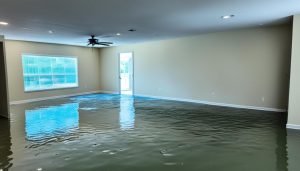Did you know that 98% of basements in the United States will face water damage at some point? Many people see water leaks as small problems. But, water damage can quietly cause big problems.
At first, you might notice it’s hard to open doors and windows. Or, you might see water stains on walls. If ignored, these signs can quickly get worse. They can weaken the foundation of your home.
Water damage isn’t just about looks; it’s about safety. It can corrode metal and rust parts, or rot wood. A sagging roof or yard cracks are early signs of damage.
Preventing water damage is key. Regular checks and quick fixes can save your home. This way, you can avoid the risk of your house collapsing.
Understanding Structural Damage from Water
Water damage can harm a building’s key supports, like walls and foundations. It weakens materials like wood and drywall, causing them to warp or sag. This can lead to structural collapse if not fixed.
Moisture in a home’s foundation can cause cracks and shifts. This makes the building unstable and may need expensive repairs.
Spotting water damage early is key. Look for damp spots, water stains, and musty smells. Peeling paint or bulging walls are also signs. Cracks in the foundation or yard show a shifting foundation.
Water can damage a home’s electrical systems, causing short circuits and fires. It also creates a moldy environment, harming wooden and drywall structures. Mold can lead to health issues like allergies and breathing problems.
Preventing water damage is crucial. Regular checks and maintenance can help. Fixing leaks, roof damage, and exterior issues quickly is important. Good ventilation in moist areas like bathrooms and kitchens helps prevent mold.
Getting help from experts like Expert Water Removal is wise. They can assess damage, reduce its effects, and restore your home. Certified experts ensure your home is safe and sound.
- Immediate consequences of water damage:
- Structural damage: Warping, rotting, and weakening of materials.
- Mold growth: Rapid proliferation due to excess moisture.
- Electrical hazards: Risk of short circuits and fires.
- Long-term consequences of water damage:
- Deterioration of building materials: Costly repairs.
- Reduced property value: Potential ongoing issues.
- Health risks: Respiratory problems and allergies.
- Belongings vulnerable to water damage:
- Furniture: Upholstered and wooden.
- Electronics: Susceptible to damage.
- Documents and photos: Ink bleeding, warping.
- Impact of water damage on structural elements:
- Walls: Weakening, blistering, mold growth.
- Floors: Warping, swelling, and rotting.
- Ceilings: Stains, discoloration, potential collapse.
Can a House Collapse from Water Damage?
Water damage can lead to a house collapse if not fixed. It weakens foundation walls, causing them to deteriorate and fail. The tragic collapse in Hamilton, reported by CBS Philly, shows the dangers of ignoring water damage.
Cracks in walls are the first sign of trouble. They can lead to expensive repairs. Bubbling paint or stains under windows warn of water damage or termites.
Uneven walls or floors suggest foundation problems. Slanted floors might mean the ground wasn’t compacted right. Falling baseboards are a clear sign of a big structural issue.
Stains under bathroom ceilings show roof leaks. This can weaken the structure. Also, if windows and doors don’t open right, it’s a sign of foundation weakness.
Water leaks are a serious issue. They can cause structural damage. Fixing water damage is key to keeping your home safe and lasting longer. So, knowing how to prevent collapse is crucial.
- Inspect for cracks on walls and address them promptly
- Watch for bubbling paint or stains, especially under windows
- Monitor for uneven or slanted floors
- Ensure proper drainage around the house foundation
- Address signs of insect infestation immediately
- Repair roof leaks and ceiling stains without delay
- Ensure that windows and doors function smoothly
Conclusion
Water damage can cause a house to collapse, making home maintenance crucial. Spotting early signs and acting fast can prevent big problems. Concrete, even with steel bars, can weaken from water damage, leading to instability.
Homes near the ocean face extra risks because of salt’s corrosive effect. This makes concrete more prone to damage. Signs like sinking earth or cracks in walls show a house might be unstable.
These signs highlight the need to keep a house’s structure strong. In rainy places, damp areas can lead to termites, mold, and rotting wood. These issues increase the risk of a house collapsing.
Look out for sloping floors, doors that don’t fit right, and cracks around chimneys. These are warning signs that need a structural engineer’s check. Regular upkeep and quick fixes are key to avoiding water damage and keeping a house stable.
Mold is another danger, affecting both the house and its occupants’ health. For big mold problems, get help from experts like Expert Water Removal. Taking care of a house’s structure keeps it safe and secure for everyone.








